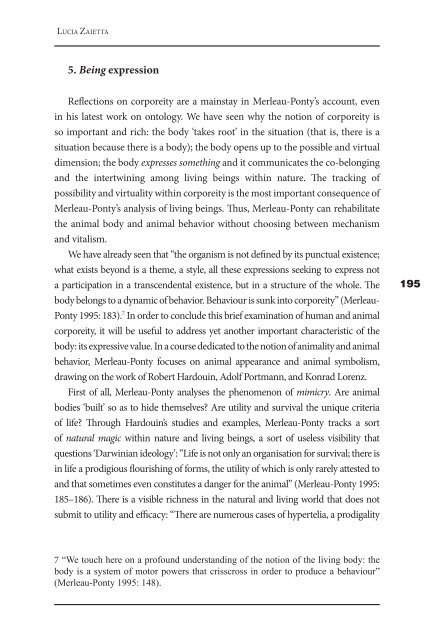phainomena
PHAINOMENA-98-99_e-verzija
PHAINOMENA-98-99_e-verzija
Create successful ePaper yourself
Turn your PDF publications into a flip-book with our unique Google optimized e-Paper software.
LUCIA ZAIETTA<br />
5. Being expression<br />
Reflections on corporeity are a mainstay in Merleau-Ponty’s account, even<br />
in his latest work on ontology. We have seen why the notion of corporeity is<br />
so important and rich: the body ‘takes root’ in the situation (that is, there is a<br />
situation because there is a body); the body opens up to the possible and virtual<br />
dimension; the body expresses something and it communicates the co-belonging<br />
and the intertwining among living beings within nature. The tracking of<br />
possibility and virtuality within corporeity is the most important consequence of<br />
Merleau-Ponty’s analysis of living beings. Thus, Merleau-Ponty can rehabilitate<br />
the animal body and animal behavior without choosing between mechanism<br />
and vitalism.<br />
We have already seen that “the organism is not defined by its punctual existence;<br />
what exists beyond is a theme, a style, all these expressions seeking to express not<br />
a participation in a transcendental existence, but in a structure of the whole. The<br />
body belongs to a dynamic of behavior. Behaviour is sunk into corporeity” (Merleau-<br />
Ponty 1995: 183). 7 In order to conclude this brief examination of human and animal<br />
corporeity, it will be useful to address yet another important characteristic of the<br />
body: its expressive value. In a course dedicated to the notion of animality and animal<br />
behavior, Merleau-Ponty focuses on animal appearance and animal symbolism,<br />
drawing on the work of Robert Hardouin, Adolf Portmann, and Konrad Lorenz.<br />
First of all, Merleau-Ponty analyses the phenomenon of mimicry. Are animal<br />
bodies ‘built’ so as to hide themselves? Are utility and survival the unique criteria<br />
of life? Through Hardouin’s studies and examples, Merleau-Ponty tracks a sort<br />
of natural magic within nature and living beings, a sort of useless visibility that<br />
questions ‘Darwinian ideology’: “Life is not only an organisation for survival; there is<br />
in life a prodigious flourishing of forms, the utility of which is only rarely attested to<br />
and that sometimes even constitutes a danger for the animal” (Merleau-Ponty 1995:<br />
185–186). There is a visible richness in the natural and living world that does not<br />
submit to utility and efficacy: “There are numerous cases of hypertelia, a prodigality<br />
195<br />
7 “We touch here on a profound understanding of the notion of the living body: the<br />
body is a system of motor powers that crisscross in order to produce a behaviour”<br />
(Merleau-Ponty 1995: 148).


